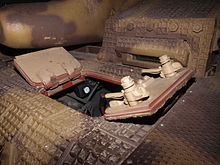Zimmer & Co.
Chemische Werke Zimmer & Co. was a company in Berlin - Plötzensee from 1921 to 1983 . Before the Second World War , it produced bituminous sealing and coating materials for the construction industry. From 1943 a coating, also called Zimmerit , was used by the German Wehrmacht to coat tanks to protect them against magnetic sticky mines .
Companies
The company Chemische Werke Zimmer & Co. , founded by Louis Zimmer in Berlin in 1921 , manufactured paints and sealants with the brand name "Zimmerit" for the construction industry. These funds were further developed and successfully used in numerous building projects. after Simon KG took a stake in it in 1925 and was headed by the chemist Hermann Simon . In 1937/38 the company was aryanized by Walter Brauer, owner of a mechanical engineering company in Berlin. During the Second World War, from 1940 onwards, it operated a branch in Lille , headed by Friedrich Joseph Pungs , with a branch in Ostend , which equipped and camouflaged the airfields and structures on the Atlantic Wall with its products.
Hermann Simon emigrated to England and built the company Evode Ltd. there. with largely the same products and z. Some also have similar names that were supplier to the Allies during World War II.
With the death of Walter Brauer, the company Zimmer & Co. was liquidated in 1983; it had long since ceased operations.
Zimmerit


Zimmerit, developed in 1943, was a concrete-like paste made from barium sulfate (40%), polyvinyl acetate (25%), ocher pigment (15%), sawdust (10%) and zinc sulfide (10%). It was applied to the armor and then cured with a blowtorch . The result was an uneven surface on which magnetic leads did not adhere well. Zimmerit was not applied flat, but with a notched spatula or with stamps in the shape of a waffle, so that a characteristic surface structure resulted. This structure should create the greatest possible distance between the armored steel surface and any sticky leads and at the same time keep the use of materials, weight and drying time as low as possible. Approximately 70 kilograms of Zimmerit were required for an assault gun .
In September 1944, the installation of Zimmerit was abruptly stopped when the rumor arose that the mixture could catch fire from impact. The rumor could be refuted by fire tests, but Zimmerit was no longer used until the end of the war.
This type of Zimmerit only became known long after the war as a replica for model construction of tanks.
Web links
Individual evidence
- ↑ Richard Grün : The concrete: production, structure and resistance to physical and chemical influences . Springer-Verlag, 1927, ISBN 978-3-642-91639-7 , p. 458 ( Google Books ).
- ↑ Evode History Project: Brochure from Zimmer & Co
- ↑ Commercial register files
- ↑ Evode History Project: Website
